

 | Journal of Renewable Materials |  |
DOI: 10.32604/jrm.2022.017513
ARTICLE
Experimental Investigation on the Mechanical Properties of Natural Fiber Reinforced Concrete
1School of Architecture and Civil Engineering, Yunnan Agricultural University, Kunming, 650000, China
2Key Laboratory of Crop Growth and Intelligent Agriculture of Yunnan Province, Yunnan Agricultural University, Kunming, 650000, China
*Corresponding Author: Jing Li. Email: li_jing69@163.com
Received: 16 May 2021; Accepted: 12 July 2021
Abstract: Recently, addition of various natural fibers to high strength concrete has aroused great interest in the field of building materials. This is because natural fibers are much cheaper and locally available, as compare to synthetic fibers. Keeping in view, this current research conducted mainly focuses on the static properties of hybridized (sisal/coir), sisal and coir fiber-reinforced concrete. Two types of natural fibers sisal and coir were used in the experiment with different lengths of 10, 20 and 30 mm and various natural fiber concentrations of 0.5%, 1.0%, and 1.5% by mass of cement, to investigate the static properties of sisal fiber reinforced concrete (SFRC), coir fiber reinforced concrete (CFRC) and hybrid fiber reinforced concrete (HFRC). The results indicate that HFRC has increased the compressive strength up to 35.98% with the length of 20 mm and with 0.5% concentration, while the CFRC and SFRC with the length of 10 mm and with 1% concentration have increased the compressive strength up to 33.94% and 24.86%, respectively. On another hand, the split tensile strength was increased by HFRC with the length of 20 mm and with 1% concentration, CFRC with the length of 10 mm and with 1.5% concentration, and SFRC with the length of 30 mm and with 1% concentration have increased up to 25.48%, 24.56% and 11.80%, respectively, while the HFRC with the length of 20 mm and with 0.5% concentration has increased the compressive strength of concrete but has decreased the split tensile strength up to 2.28% compared to PC. Overall, using the HFRC with the length of 20 mm and with 1% concentration provide the maximum output in terms of split tensile strength.
Keywords: Sisal fiber reinforced concrete; coir fiber reinforced concrete; hybrid fibers; compressive and tensile strength
Since the beginning of human civilization, plant fibers have a long history, in which natural fibers are used as reinforce building materials to improve the mechanical properties of a material. Dating back to the Egyptian period, natural fibers (such as straw and horsehair) were mixed used in the formation of mud walls and mud roofs [1,2]. Due to growing environmental concerns, the demand for environmental friendly building materials with good mechanical properties is increasing day by day [3–5]. With the support of environmental awareness and shortage of global energy resources, more and more chemical fibers have been replaced by natural fibers to strengthen the composite enhancer [6–10]. Compared with chemical fibers, natural fiber have not only the characteristics to be renewable and recyclable, but also has few other advantages including high yield, low processing cost, and low density [11,12]. Furthermore, the natural fiber industry accounts for 30% of global carbon dioxide (CO2), and it emits and consumes approximately 50% (weight%) of raw materials than other raw materials [13]. The production of ordinary Portland cement not only requires a lot of energy but also releases a large number of greenhouse gases. Because of high energy consumption and CO2 emissions, the researcher has investigated for alternative building materials [12]. Due to the increasing consideration towards the environment to develop of environmental friendly materials, natural fibers are more favored than synthetic fibers as concrete reinforcement materials for decades [14]. Due to the unsustainability of the modern construction industry, the search for alternative building materials has received great attention.
Therefore, in recent years, researchers around the world have turned their attention to the study of natural fiber-reinforced composite materials [11,15–18]. Few researchers have recognized natural fiber to use as reinforced in the construction industry to attain a sustainable material [19,20]. By the use of natural fiber reinforced concrete is developed by using various types of fibers, such as coir, sisal, bamboo, date, husk, pineapple, and flax [21,22]. Moreover, in recent years, the usage of green materials in structures has developed remarkably due to its advantages in building construction [23,24]. More recently, the coir, sisal, and other natural fibers (e.g., pine and wheat fibers) are abundantly available in Yunnan Province of China, which are frequently used in the construction of walls and houses due to its economic and environmentally friendly characteristics as well as fully satisfied [25].
Those reinforced structures in which we use two or more types of fiber together to make a single matrix structure are known as hybrid fiber-reinforced composites [26–28]. Till now a variety of methods have been applied to improve the mechanical properties of natural fibers such as pre-treatment of fiber, using of compatibilizers or additives in matrix and hybridization of natural/synthetic/nanofibers [29,30]. By selecting the proper fiber, not only the cost of materials can be reduced, but the performance of concrete composite can be significantly produced by using the hybridization of two or more natural fiber matrix [31]. Sathishkumar et al. [32] studied three different natural fibers composite of snake grass, coir and banana fibers. He also determined the flexural and tensile strength of snake grass, grass/coir, and grass/banana hybrid fiber-reinforced composite. The results showed that compared to snake grass the grass/coir and grass/banana hybrid fiber-reinforced composite improved the tensile and flexural strength. Venkata Reddy et al. [33] studied the fabric content of kapok and sisal hybrid fiber composite and the relative volume ratio between fibers. They determined that the higher sisal fiber content caused an enhanced rigidity and flexural properties of concrete. While studying the sisal and banana as a hybrid fiber in different relative quantities with 1:1, 1:3, and 3:1, have shown the highest activation energy, tensile strength, and flexural strength at 1:3 relative quantity [34].
Ahamed et al. [35] studied coir including sisal, jute, hemp, banana, and pineapple fibers to evaluate the properties of concrete. They determined that since each organic fiber has its properties, the natural fiber can increase as well as decrease some properties of concrete. However, Fadhil et al. [36] have arranged a study to determine the effect of sisal and palm fiber reinforced concrete, to investigate the influence of natural fiber concertation by using 0.6%, 1.20%, and 1.8% of total mixture volume, and determined compressive strength, split tensile strength flexural strength and impact resistance of concrete. Similarly, Sivaraja et al. [37] reported that the addition of natural fibers (coir and sugarcane) improves the compressive, split tensile and bending properties of concrete. Izquierdo et al. [38] presented a project to study the mechanical properties of masonry elements made of sisal fibers and concrete. He has determined the compression behavior of hollow blocks individually, and the possible future development of the implementation model was précised. Concrete is weak in tensile strength, that’s why more researchers paying attention to improve the tensile performance of concrete [39,40]. Furthermore, suitable thermochemical properties will have an impact on mechanical properties, especially depending on tensile strength and interfacial bond of concrete reinforced with sisal fibers composites [41,42]. dos Santos et al. [43] arranged a relative study on the properties of sisal and pissava fibers. He examined the compressive strength, tensile strength, workability, deformation, and bending ability are considered. Sisal was found to be more effective as reinforced. Prakash et al. [44] used coconut shell to replace conventional aggregate in concrete to produce lightweight coconut shell concrete. Furthermore, by adding the sisal fiber as reinforced concrete with the concentration of 1%, 2%, 3%, and 4% based on the weight of binders, and studied the mechanical properties of concrete. The results showed by adding 3% of sisal fibers increased the compressive strength by up to 6%, while increased tensile strength by up to 14%. Agopyan et al. [45] replaced the sisal and coir fibers on asbestos and implemented three-point bending test. The experimental results showed that sisal and coir both had the maximum load endured but by comparing coir tile and sisal tile, the coir showed maximum strength. Sisal and coir fiber reinforced concrete has been broadly investigated by previous researchers, and it is commonly recognized that the optimum concentration of fiber varies as the source of fiber changes [11]. Mechanical strength performance of natural fiber reinforced concrete is effected by the length of fiber, fiber concentration and orientation [46]. The excellency of natural fibers reinforced concrete is mainly depending on the volume of fiber as well as on length of fibers, thus different researcher has used different percentage of fiber volume and different length [47–49].
The main objectives of this research are to ensure economic structure as well also to improve the rigidity of reinforced concrete pavements using natural fibers. This research determines the mechanical properties of natural fiber in concrete over a certain percentage along using different lengths of fibers to study the influence of the content of fiber and the length effects on the compressive strength and split tensile strength of concrete.
The ordinary Portland cement type 1 (P.42.5) produced was used in this experiment for all mixes. It meets the requirement of ordinary cement ASTM C150 standard, having a specific surface area of 346 m2/kg, and a specific gravity of 3.12 g/cm3 with the initial setting time and final setting time of 159 and 210 min, respectively.
The fine aggregates were used dry sand in this study passed through a 4.75 mm sieve. The compacted and loose bulk density of fine aggregates was 1688 and 1600 kg/m3, respectively. The coarse aggregates passed through 12.5 mm sieves and retained on a 4.75 mm sieve. The compacted and loose bulk density of fine aggregates was 1530 and 1422 kg/m3. The aggregates used were not contained oversize or flaky materials. They were angular, hard, and of required grade size and shall be blackish or grey.
Two types of fibers were selected for this research, namely sisal and coir fiber. The coir fiber was selected from the Hainan Province of China and the sisal fiber was selected from the Yunnan Province of China as shown in Fig. 1. The available sisal and coir fibers were dipped in fresh tap water for 15 to 20 min. The purpose of dipping is to remove the dust from the surface of the fibers. After that, fibers were air-dried for 24 h, and then the thermal treatment was applied on fibers, which were placed in a ventilated oven at 150°C for 8 h and used in concrete. the thermal treatment achieved an improvement of initial crystallization of the cellulose to the improved strength and the resistance of the sisal fiber [40]. The surface treatment of natural fiber-reinforced composite can improve the performance of bonding between fibers and filler materials [50] studied the effect of mercerization (NaOH 4%), salination and heat treatment (150°C for 8 h) on the tensile strength in woven sisal fabric reinforced natural rubber composites. The study results showed that the maximum values are obtained by heat treatment composite instead of other chemical alterations.
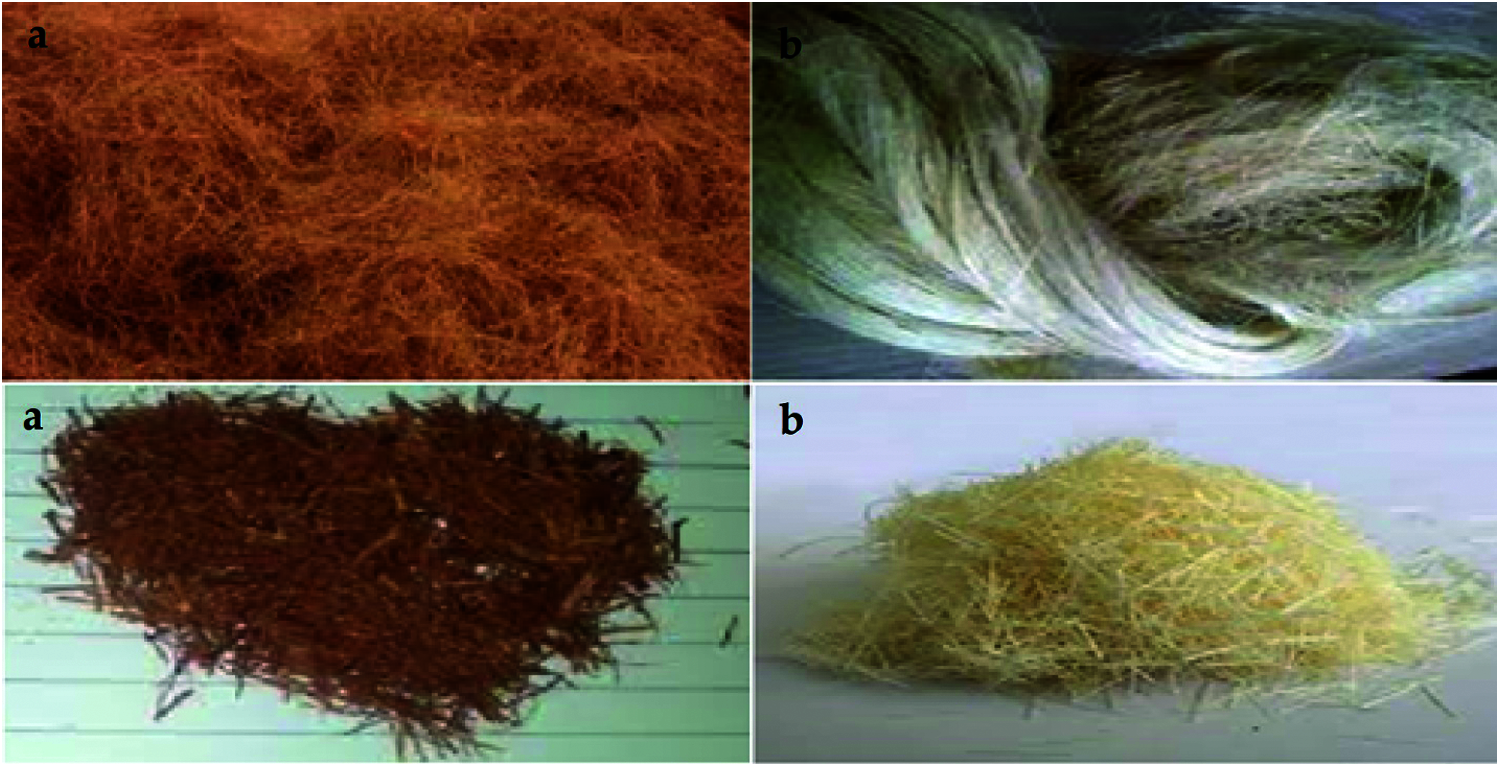
Figure 1: (a) Coir fibers and (b) sisal fibers
Chemical composition and physical and mechanical properties of natural fibers is shown in Tables 1 and 2. respectively. In this study, the fiber was cut with the length of 10 mm, 20 mm, 30 mm and mixed with a different proportion of 0%, 0.5%, 1% and 1.5 % respectively added by mass of cement as shown in Table 3.



2.2.2 Mixture Proportions and Preparation
The specimens having a cylindrical shapes with a diameter of 100 mm and a height of 200 mm for determining the compressive and split tensile strength (AASHTO M 205). The concrete mix design ratio for cement, sand, and aggregate was kept 1:1:2 (M25) for all specimens with a 0.50 water-cement ratio. Clean and free of deleterious matter tap water was used in the concrete mix. A small drum mixing machine was used for mixing the concrete. Fine and coarse aggregates were mixed for two minutes, after mixing the aggregates put the cement and fiber and remixed for two minutes, and after adding water again mixed for two minutes. Finally, the concrete was cast in molds and vibrated for 180 s using an electric vibrating table machine to remove trapped air from the molds. All specimens were unmolded after 24 h of their casting and placed in a concrete automatic curing room till the age of testing. The numeric figures along with labels show the number of samples for each specimen. All specimens of concrete were tested after 28 days according to ASTM C31/C31M. In Table 3. natural fiber is used by the mass of cement. PC represents a plain concrete specimen. SB, SC, and SD represent sisal fiber reinforced concrete specimens with the concentration of 0.5%, 1.0%, and 1.5% with the length of 10, 20, and 30 mm, respectively. CB, CC, CD were labeled for coir fiber reinforced concrete specimens with different natural fiber concentrations of 0.5%, 1.0%, and 1.5% with the length of 10, 20, and 30 mm, respectively. while HB, HC, HD were labeled for hybrid (sisal/coir) fiber reinforced concrete specimens with different natural fiber concentrations of 0.5%, 1.0%, and 1.5% with the length of 10, 20, and 30 mm, respectively.
2.2.3 Compressive Strength and Split Tensile Strength
The cylindrical shape specimens were cast for compressive and split tensile strength, with a diameter of 100 mm and a height of 200 mm for each mix of CFRP, SFRP, and HFRC. Prepared specimens for determining the compressive strength and split tensile were stored in a place with a minimum of 80% relative humidity at the temperature of 27 ± 2°C for 24 h. After that, the specimens are taken to place in a steam curing automatic temperature control system room with a temperature of 20 ± 2°C and a relative humidity of 95%. To obtain the compressive test results, the average of three specimens values was recorded after 28 days of casting by using the Electro-Hydraulic Pressure testing machine controlled by a computer with 5000 kN loading. All specimens were caped with sulphur for uniform distribution of load before testing. All test specimens applying load 1.2 N/(mm2/min) to 2.4 N/(mm2/min) and maintained the rate once adjusted until failure according to ASTM C 39. To determine the compressive strength, 90 specimens were prepared and tested. While the same testing machine was used to perform the split tensile strength and a jig was used for the alignment of a specimen. The applied load without shock and increasing with the nominal rate from 1.2 N/(mm2/min) to 2.4 N/(mm2/min). The jig was used for the alignment of the concrete sample as shown in Fig. 2.
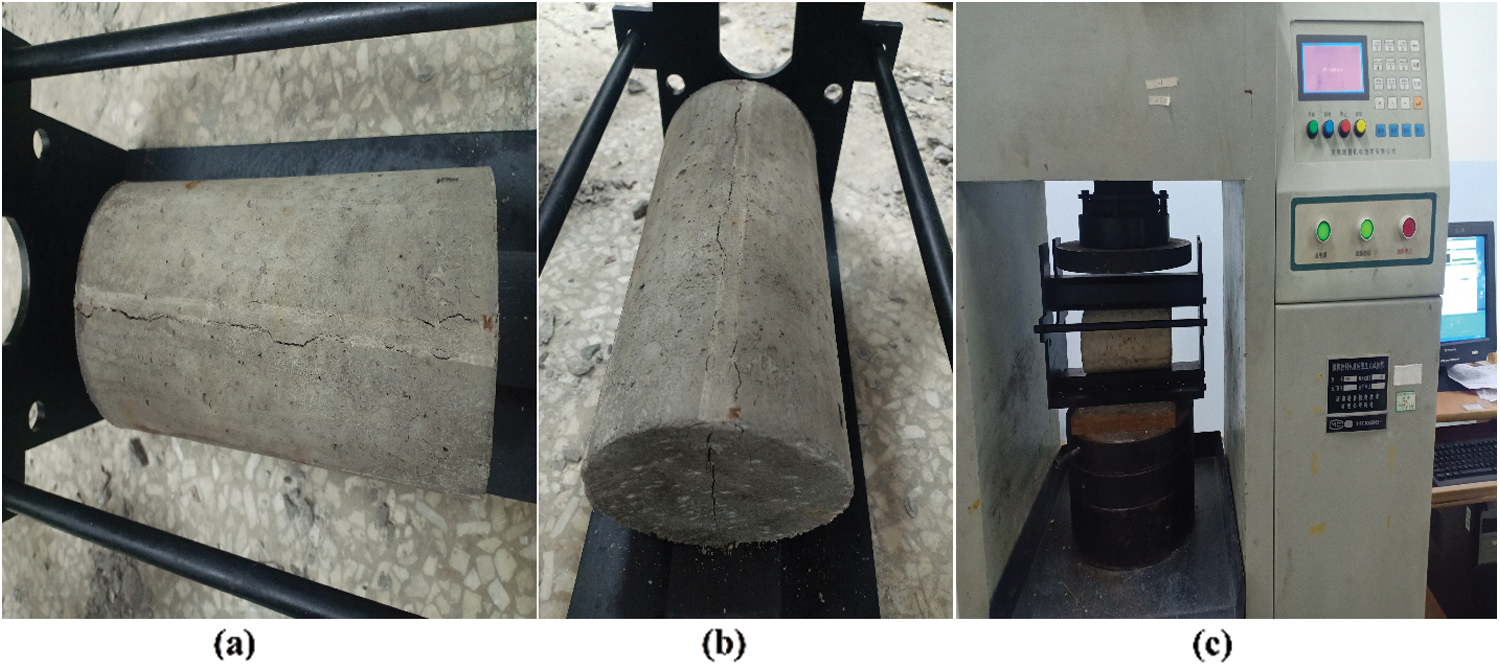
Figure 2: (a, b) Alignment jig was used for the specimen alignment during testing (c) Pressure testing machine controlled by a computer used to perform the split tensile strength
The slump test was performed to approach the workability of natural fiber concrete; the results show that due to the fiber water absorption, the slump was reduced by the increase of fibers cement concentration. The addition of natural fiber to plane concrete can improve the stability and cohesion of the mixture, which leads to a decrease in the workability of the concrete [36]. Each fiber mix has shown different slump values. The plain concrete slump was 90 mm. HFRC has shown the highest slump compared to other fiber concrete mixes presented in Table 4. The concentration of 0.5% has shown a higher slump as compare to other natural fiber concentration, and with the higher concentration the slump value was decreased.

Compressive strength is a very important property of concrete. This research demonstrates that the compressive strength of concrete reinforced using sisal, coir, and hybrid of both sisal and coir has increased a specific percentage. Combining two or more natural fibers in a mutual matrix to improve the mechanical properties of composite and obtain effective reinforced concrete [54–56]. Different fibers are hybridized to improve the mechanical properties of concrete [57]. Both positive and negative results have been reported to add natural fibers to the matrix [58–60]. It also shows a decrease in percentage in some samples. Three types of different fibers were selected to be used including coir fiber and studied the compression behaviors of concrete by considering to use of different lengths and sizes of fibers at the 28 days of specimens are presented, as compared to PC. The decrease in strength can be attributed to the decrease in adhesion between fiber and cement slurry, which gave the results in the need for higher compaction energy and the required compressive strength [59,61].
The SC1 and CC1 (both with 10 mm length and with 1% concentration) has shown the best effect on the compressive strength improvement of 24.86% and 33.94 respectively, as shown in Figs. 3 and 4. The SB2, SC2, SC3, SD3 and SD1 has also slightly increased the compressive strength up to 24.86%, 21.88%, 21.66%, 13.39 % and 7.36 % respectively, while SD2, SB1 and SB3 have decreased the compressive strength of concrete by 12.17%, 10.62% and 6.02% respectively compared to PC. The results show that the hybrid fiber concrete compressive strength is slightly improved up to 35.98% by HB2 (20 mm length and with 0.5% concentration) as compared to PC Fig. 5. SFRC has shown fewer cracks on the concrete surface as compare to HFRC as shown in Fig. 6. CFRC showed the improvement in strength of CC1, CD3, CD1, CC2, CD2, CC3, CB1 and CB3 which slightly increased the compressive strength up to 33.94%, 31.91%, 29.13%, 24.03%, 23.49%, 21.61% 15.45% and 11.05%, respectively, while CB2 has shown decrease in compressive strength of concrete by 1.64% as compared to PC shown Fig. 4.
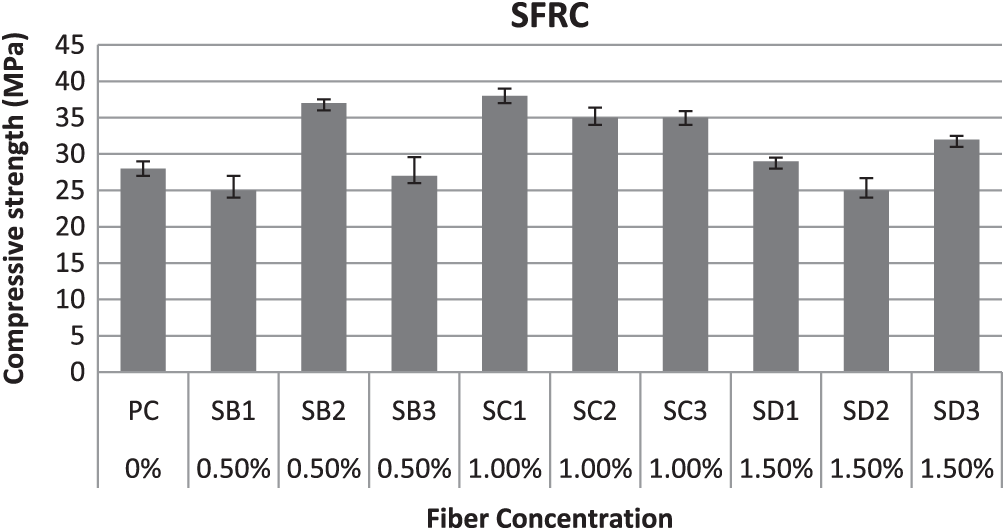
Figure 3: Compressive strength of coir fiber reinforced concrete (CFRC)
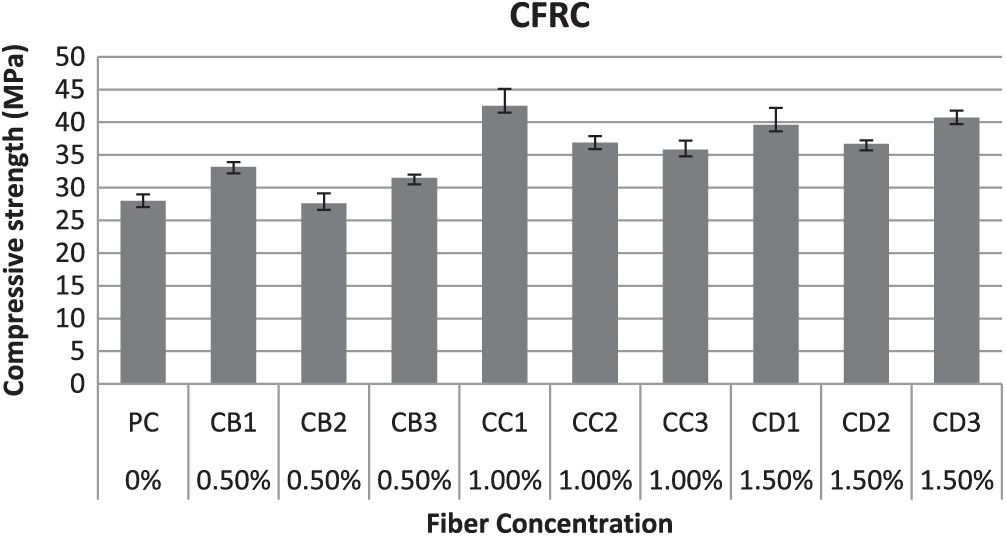
Figure 4: Compressive strength of hybrid (coir/sisal) fiber reinforced concrete (HFRC)
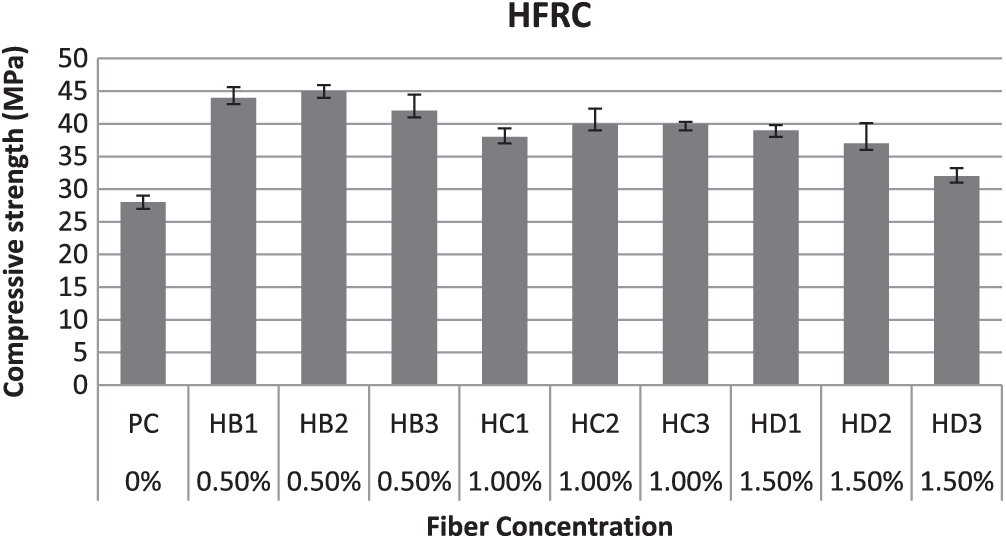
Figure 5: Compressive strength of hybrid (coir/sisal) fiber reinforced concrete (HFRC).
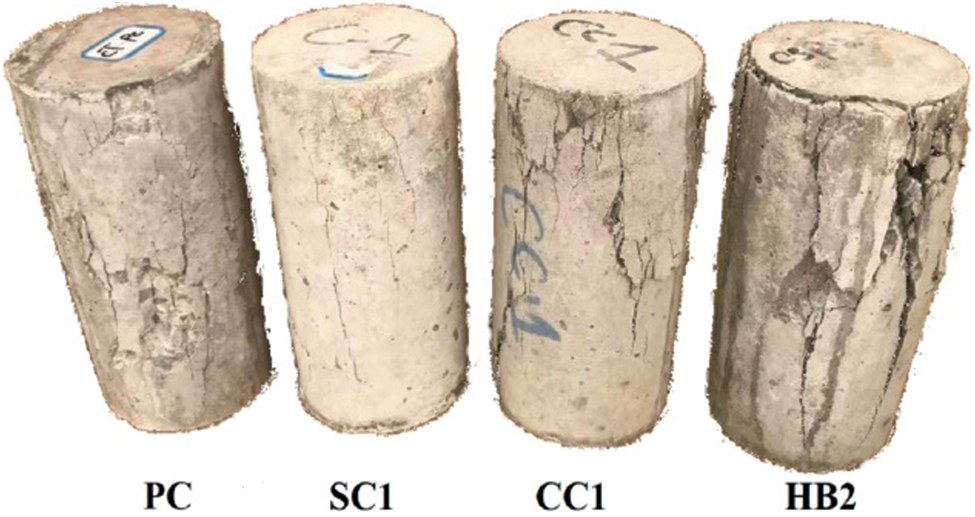
Figure 6: Examples of PC, SFRC, CFRC and HFRC after compressive tests specimens at the age of 28 days
All mixes of hybrid reinforced concrete showed the maximum strength as compared to PC as well as SFRC and CFRC. HB2, HB1, HB3, HC2, HC3, HD1, HC1, HD2 and HD3 has increased the strength respectively up to 35.98%, 34.15%, 31.58%, 29.04%, 28.51%, 27.14%, 25.77%, 19.91% and 11.45% compared to PC shown Fig. 5. Natural fiber length as well as the fiber concentration has affected the compressive strength. The use of short fiber with a length of 10 mm and the concentration of 1% has increased the SFRC and CFRC, on another hand, the HFRC has shown the increment on different concentrations as compared to SFRC and CFRC. HFRC has increased the compressive strength by using the length of 20 mm and the concentration of 0.5%. SFRC and CFRC and shown higher improvement by using 10 mm with 1% of fiber concentration, while HFRC has shown higher improvement by using 20 mm with 0.5% of fiber concentration. By using short fiber having the length of 10 mm has shown higher compressive strength by coir and sisal fiber reinforced concrete, while using hybrid fiber reinforced concrete has shown higher compressive strength by using 20 mm fiber length with different fiber concentrations.
Sisal and coir fibers have extraordinary cellulose content that increases split tensile strength, flexural and sensible tensile strength, and are also not expensive as compared to other natural fibers [62]. Sisal fiber reinforced concrete SC3 (fiber content of 1.5% with the length of 20 mm) has shown the higher improvement in the strength up to 11.80% as shown in Fig. 7. The coir fiber reinforced concrete CD2 (fiber content of 1.5% with the length of 20 mm) has improved up to 24.65% as shown Fig. 8. The hybrid fiber reinforced concrete HC2 (fiber content of 1% with the length of 20 mm) has increased split tensile strength up to 25.48% as shown in Fig. 9. Abass et al. [59] concluded that 1% of using SFRC has improved Young’s modulus split tensile strength of concrete. HFRC have shown highest improvement in tensile strength compared to SFRC and CFRC.
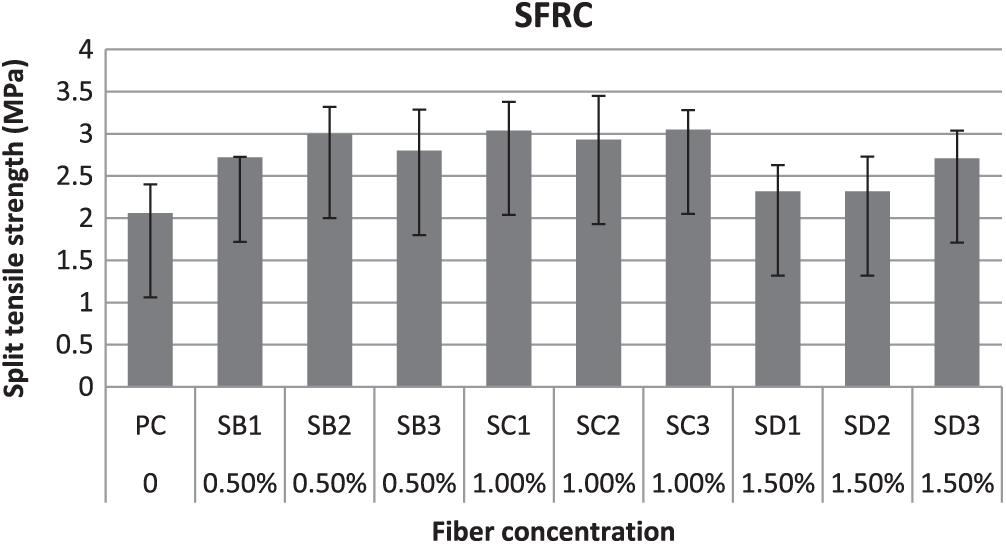
Figure 7: Split tensile strength of coir fiber reinforced concrete (CFRP)
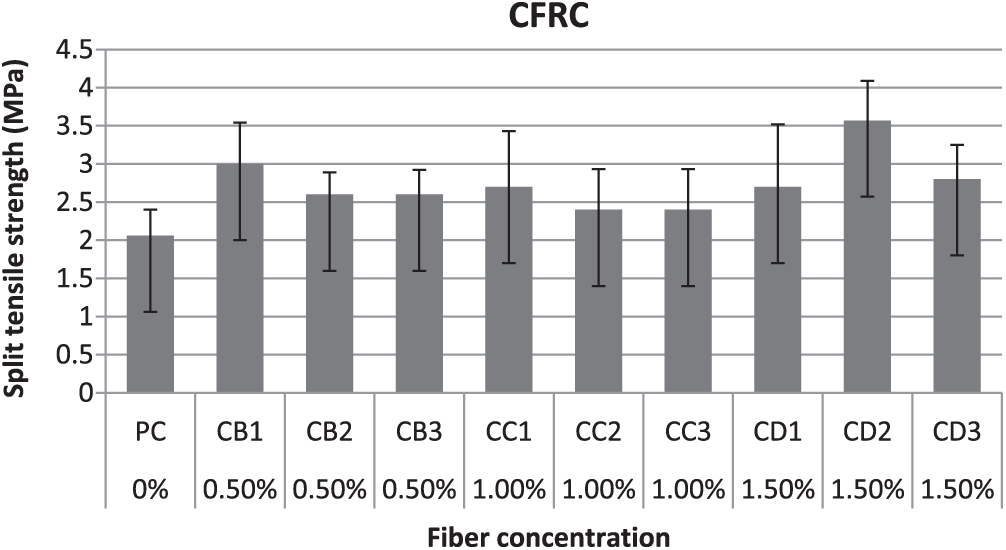
Figure 8: Split tensile strength of hybrid fiber reinforced concrete (HFRC)
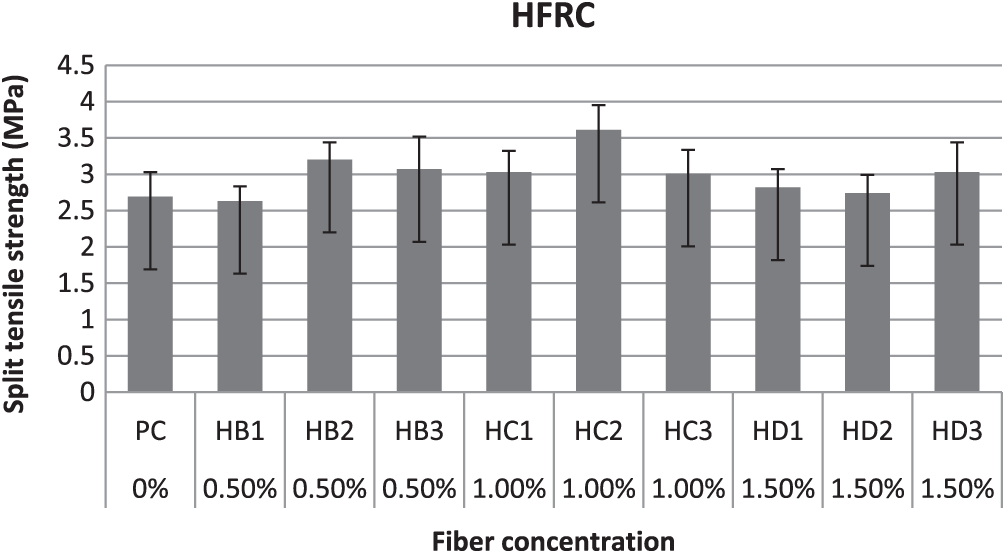
Figure 9: Split tensile strength of hybrid fiber reinforced concrete (HFRC).
The SC3, SC1, SB2, SC2, SB3, SB1 and SD3 has showed Increased in split tensile strength by 11.80%, 11.51%, 10.33%, 8.19%, 3.58% and 0.74% respectively as compared to PC as shown in Fig. 6. The SFRC tensile strengths are not uniform lengthwise. Hence, different lengths of fiber has different mechanical properties [63]. The CFRC specimens have shown an incensement in split tensile strength of CD2, CB1, CD3, CD1, and CC1 with 24.65%, 10.45%, 4.27%, 2.54%, and 1.82%, respectively as compared to PC, as shown in Fig. 8. Some researchers also reported coir and sisal fiber to have a negative influence on the split tensile strength of CFRC [59,64,65]. The hybrid fiber reinforced concrete HC2, HB2, HB3, HD3, HC1, HC3, HD1, and HD2 has increased the split tensile strength of concrete by 25.48%, 16.02%, 12.57%, 11.32%, 10.53%, 4.69%, and 1.94%, respectively, and HB1 has shown a decrease in the split tensile strength by 2.28% compared to PC as shown in Fig. 9. Natural fiber reinforced concrete has increased split tensile strength on different lengths as well as on the different volumes of fiber. Fig. 10. have presented the specimen after the test, the PC specimens have shown more ductility as compared to the addition of natural fibers. Split tensile result has shown strength improvement by using fiber length of 20 mm in CFRC and HFRC, while SFRC has shown higher split tensile strength on 30 mm length of fiber. Also, has SFRC and CFRC has shown strength improvement by using 1.5% of fiber concentration, while HFRC has shown the highest split tensile strength by using 1% fiber concentration.
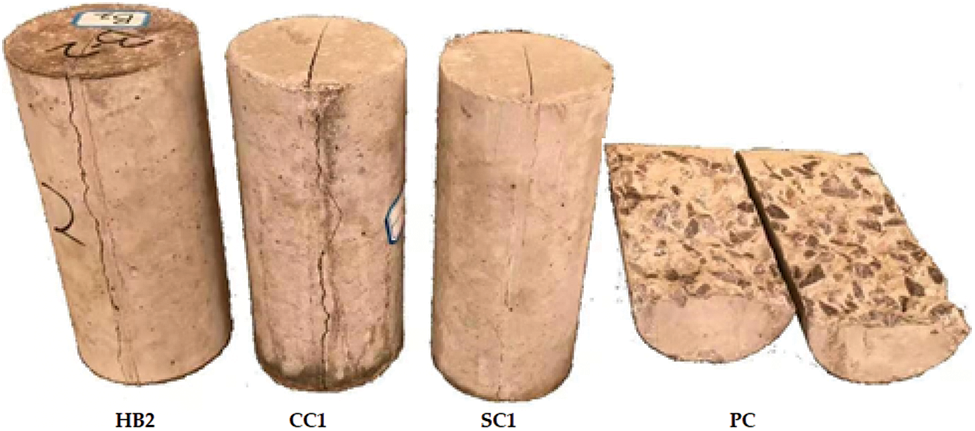
Figure 10: Examples of HFRC, CFRC, SFRC, and PC fiber reinforced concrete specimens after splitting test at the age of 28 days
The study presented has shown that using natural fiber decreased the slump of concrete, while the increase of natural fiber concentration decreased the slump values by all specimens. Furthermore, the use of hybrid natural fiber has highly increased the compressive as well as split tensile strength as compare to the sisal and coir fiber reinforced. Several factors influence the mechanical properties of natural fibers to reinforce concrete composite, such as fiber length, fiber structure, fiber treatment, and hybridization by combining different types of natural/natural fibers. The best compressive strength of sisal and coir fiber was observed for 1% of fiber concentration and with the length of 10 mm, which increased up to 24.86% and 33.94%, respectively. However, the hybrid fiber concrete showed the best compressive strength up to 35.98% with 20 mm length and with 0.5% concentration as compared to PC. While the split tensile strength was improved by most the fiber mixes, the best improvement of split tensile strength was shown by HFRC with the fiber content of 1% and 20 mm length up to 25.48%. However, the coir fiber has also slightly improved the split tensile strength up to 24.65% by using a fiber content of 1.5% with the length of 20 mm, whereas the sisal fiber has improved the split tensile results up to 11.80% by using fiber content of 1% with the length of 30 mm.
Further research is recommended to improve the mechanical properties and long-term effects of the approach used are recommended. For natural fibers, further study is suggested to improve dynamic properties of natural fiber reinforced concrete and develop the reinforcement of recyclable fibers, to practice more durable and environmental friendly composites materials. Finally, for waste materials, it is recommended to further study the long-term effect of waste fibers and its use in construction materials.
Acknowledgement: The authors thank Samantha C. Karunarathna (senior scientist) and Samiullah Khan for Proofreading, Nauman Khan for the fiber treatment, and for throughout the experiment.
Funding Statement: This work has been supported by the Yunnan Science and Technology Major Project, Yunnan China under Grant No. 202002AE090010.
Conflicts of Interest: The authors declare that they have no conflicts of interest to report regarding the present study.
1. da Fonseca, R. P., Rocha, J. C., Cheriaf, M. (2021). Mechanical properties of mortars reinforced with Amazon rainforest natural fibers. Materials, 14(1), 155. DOI 10.3390/ma14010155. [Google Scholar] [CrossRef]
2. Juarez, C., Duran, A., Valdez, P., Fajardo, G. (2007). Performance of “Agave lecheguilla” natural fiber in portland cement composites exposed to severe environment conditions. Building and Environment, 42(3), 1151–1157. DOI 10.1016/j.buildenv.2005.12.005. [Google Scholar] [CrossRef]
3. Mahmud, S., Hasan, K. F., Jahid, M. A., Mohiuddin, K., Zhang, R. et al. (2021). Comprehensive review on plant fiber-reinforced polymeric biocomposites. Journal of Materials Science, 2021, 1–34. DOI 10.1007/s10853-021-05774-9. [Google Scholar] [CrossRef]
4. Memon, M. J., Jhatial, A. A., Murtaza, A., Raza, M. S., Phulpoto, K. B. et al. (2021). Production of eco-friendly concrete incorporating rice husk ash and polypropylene fibres. Environmental Science and Pollution Research, 2021, 1–17. DOI 10.1007/s11356-021-13418-3. [Google Scholar] [CrossRef]
5. Olivito, R. S., Cevallos, O. A., Carrozzini, A. (2014). Development of durable cementitious composites using sisal and flax fabrics for reinforcement of masonry structures. Materials & Design, 57, 258–268. DOI 10.1016/j.matdes.2013.11.023. [Google Scholar] [CrossRef]
6. Poorsaheli, H. B., Behravan, A., Aghda, S. T. T. (2021). Durability performance of hybrid reinforced concretes (steel fiber + polyolefin fiber) in a harsh marine tidal zone of Persian Gulf. Construction and Building Materials, 266, 121176. DOI 10.1016/j.conbuildmat.2020.121176. [Google Scholar] [CrossRef]
7. Qiao, X., Ni, S., Lu, H., Wang, X., Zhou, X. (2021). A novel method to prepare chemical fibers by plasticizing cotton with 1-allyl-3-methylimidazolium chloride. International Journal of Biological Macromolecules, 166, 1508–1512. DOI 10.1016/j.ijbiomac.2020.11.030. [Google Scholar] [CrossRef]
8. Rostami, R., Zarrebini, M., Mandegari, M., Sanginabadi, K., Mostofinejad, D. et al. (2019). The effect of concrete alkalinity on behavior of reinforcing polyester and polypropylene fibers with similar properties. Cement and Concrete Composites, 97, 118–124. DOI 10.1016/j.cemconcomp.2018.12.012. [Google Scholar] [CrossRef]
9. Rucka, M., Wojtczak, E., Knak, M., Kurpińska, M. (2021). Characterization of fracture process in polyolefin fibre-reinforced concrete using ultrasonic waves and digital image correlation. Construction and Building Materials, 280, 122522. DOI 10.1016/j.conbuildmat.2021.122522. [Google Scholar] [CrossRef]
10. Suda, V. R., Sutradhar, R. (2021). Strength characteristics of micronized silica concrete with polyester fibres. Materials Today: Proceedings, 38, 3392–3396. DOI 10.1016/j.matpr.2020.10.569. [Google Scholar] [CrossRef]
11. Shah, I., Jing, L., Fei, Z. M., Yuan, Y. S., Farooq, M. U. et al. (2021). A review on chemical modification by using sodium hydroxide (NaOH) to investigate the mechanical properties of sisal, coir and hemp fiber reinforced concrete composites. Journal of Natural Fibers, 2021, 1–19. DOI 10.1080/15440478.2021.1875359. [Google Scholar] [CrossRef]
12. Silva, G., Kim, S., Aguilar, R., Nakamatsu, J. (2020). Natural fibers as reinforcement additives for geopolymers–a review of potential eco-friendly applications to the construction industry. Sustainable Materials and Technologies, 23, e00132. DOI 10.1016/j.susmat.2019.e00132. [Google Scholar] [CrossRef]
13. Pacheco-Torgal, F., Jalali, S. (2012). Earth construction: Lessons from the past for future eco-efficient construction. Construction and Building Materials, 29, 512–519. DOI 10.1016/j.conbuildmat.2011.10.054. [Google Scholar] [CrossRef]
14. Matheu, P. S., Ellis, K., Varela, B. (2015). Comparing the environmental impacts of alkali activated mortar and traditional portland cement mortar using life cycle assessment. IOP Conference Series: Materials Science and Engineering. Vol. 96, No. 1, 012080. IOP Publishing. DOI 10.1088/1757-899X/96/1/012080. [Google Scholar] [CrossRef]
15. Asaithambi, B., Ganesan, G., Kumar, S. A. (2014). Bio-composites: Development and mechanical characterization of banana/sisal fibre reinforced poly lactic acid (PLA) hybrid composites. Fibers and Polymers, 15(4), 847–854. DOI 10.1007/s12221-014-0847-y. [Google Scholar] [CrossRef]
16. Pandey, J. K., Ahn, S. H., Lee, C. S., Mohanty, A. K., Misra, M. et al. (2010). Recent advances in the application of natural fiber based composites. Macromolecular Materials and Engineering, 295(11), 975–989. DOI 10.1002/mame.201000095. [Google Scholar] [CrossRef]
17. Shen, X., Jia, J., Chen, C., Li, Y., Kim, J. K. et al. (2014). Enhancement of mechanical properties of natural fiber composites via carbon nanotube addition. Journal of Materials Science, 49(8), 3225–3233. DOI 10.1007/s10853-014-8027-4. [Google Scholar] [CrossRef]
18. Chen, X., Gu, S. Y., Ren, J. (2014). Research progress on processing of PLA/natural fiber composites. Engineering plastics application, pp. 9. Beijing: China Academic Journal Electronic Publishing House. [Google Scholar]
19. Cevallos, O. A., Olivito, R. S. (2015). Effects of fabric parameters on the tensile behaviour of sustainable cementitious composites. Composites Part B: Engineering, 69, 256–266. DOI 10.1016/j.compositesb.2014.10.004. [Google Scholar] [CrossRef]
20. Hakamy, A., Shaikh, F. U. A., Low, I. M. (2014). Characteristics of hemp fabric reinforced nanoclay–cement nanocomposites. Cement and Concrete Composites, 50, 27–35. DOI 10.1016/j.cemconcomp.2014.03.002. [Google Scholar] [CrossRef]
21. Kumar, K. S., Siva, I., Rajini, N., Jappes, J. W., Amico, S. C. (2016). Layering pattern effects on vibrational behavior of coconut sheath/banana fiber hybrid composites. Materials & Design, 90, 795–803. DOI 10.1016/j.matdes.2015.11.051. [Google Scholar] [CrossRef]
22. Shibata, S., Cao, Y., Fukumoto, I. (2005). Press forming of short natural fiber-reinforced biodegradable resin: Effects of fiber volume and length on flexural properties. Polymer Testing, 24(8), 1005–1011. DOI 10.1016/j.polymertesting.2005.07.012. [Google Scholar] [CrossRef]
23. Lertwattanaruk, P., Suntijitto, A. (2015). Properties of natural fiber cement materials containing coconut coir and oil palm fibers for residential building applications. Construction and Building Materials, 94, 664–669. DOI 10.1016/j.conbuildmat.2015.07.154. [Google Scholar] [CrossRef]
24. Liew, K. M., Sojobi, A. O., Zhang, L. W. (2017). Green concrete: Prospects and challenges. Construction and Building Materials, 156, 1063–1095. DOI 10.1016/j.conbuildmat.2017.09.008. [Google Scholar] [CrossRef]
25. Wang, W., Zhang, T., Chouw, N., Li, Z., Xu, Z. (2020). Dynamic compressive behaviour of coconut fibre-reinforced concrete composite. Magazine of Concrete Research, 72(21), 1125–1134. DOI 10.1680/jmacr.18.00578. [Google Scholar] [CrossRef]
26. Haseena, A. P., Dasan, K. P., Unnikrishnan, G., Thomas, S. (2005). Mechanical properties of sisal/coir hybrid fibre reinforced natural rubber. Progress in Rubber Plastics and Recycling Technology, 21(3), 155–181. DOI 10.1177/2F147776060502100301. [Google Scholar] [CrossRef]
27. Panthapulakkal, S., Raghunanan, L., Sain, M., Kc, B., Tjong, J. et al. (2017). Natural fiber and hybrid fiber thermoplastic composites: Advancements in lightweighting applications. Green composites. pp. 39–72. Woodhead Publishing, Sawston, United Kingdom. DOI 10.1016/B978-0-08-100783-9.00003-4. [Google Scholar] [CrossRef]
28. Rajak, D. K., Pagar, D. D., Menezes, P. L., Linul, E. (2019). Fiber-reinforced polymer composites: Manufacturing, properties, and applications. Polymers, 11(10), 1667. DOI 10.3390/polym11101667. [Google Scholar] [CrossRef]
29. Saba, N., Paridah, M. T., Abdan, K., Ibrahim, N. A. (2016). Effect of oil palm nano filler on mechanical and morphological properties of kenaf reinforced epoxy composites. Construction and Building Materials, 123, 15–26. DOI 10.1016/j.conbuildmat.2016.06.131. [Google Scholar] [CrossRef]
30. Senthilkumar, K., Saba, N., Rajini, N., Chandrasekar, M., Jawaid, M. et al. (2018). Mechanical properties evaluation of sisal fibre reinforced polymer composites: A review. Construction and Building Materials, 174, 713–729. DOI 10.1016/j.conbuildmat.2018.04.143. [Google Scholar] [CrossRef]
31. Jacob, M., Thomas, S., Varughese, K. T. (2004). Mechanical properties of sisal/oil palm hybrid fiber reinforced natural rubber composites. Composites Science and Technology, 64(7–8), 955–965. DOI 10.1016/S0266-3538(03)00261-6. [Google Scholar] [CrossRef]
32. Sathishkumar, T. P., Navaneethakrishnan, P., Shankar, S., Kumar, J. (2013). Mechanical properties of randomly oriented snake grass fiber with banana and coir fiber-reinforced hybrid composites. Journal of Composite Materials, 47(18), 2181–2191. DOI 10.1177/2F0021998312454903. [Google Scholar] [CrossRef]
33. Venkata Reddy, G., Venkata Naidu, S., Shobha Rani, T. (2009). A study on hardness and flexural properties of kapok/sisal composites. Journal of Reinforced Plastics and Composites, 28(16), 2035–2044. DOI 10.1177/2F0731684408091682. [Google Scholar] [CrossRef]
34. Idicula, M., Malhotra, S. K., Joseph, K., Thomas, S. (2005). Dynamic mechanical analysis of randomly oriented intimately mixed short banana/sisal hybrid fibre reinforced polyester composites. Composites Science and Technology, 65(7–8), 1077–1087. DOI 10.1016/j.compscitech.2004.10.023. [Google Scholar] [CrossRef]
35. Ahamed, M. S., Ravichandran, P., Krishnaraja, A. R. (2021). Natural fibers in concrete–A review. IOP Conference Series: Materials Science and Engineering, Vol. 1055, No. 1, 012038. IOP Publishing, Erode, India. DOI 10.1088/1757-899X/1055/1/012038. [Google Scholar] [CrossRef]
36. Fadhil, S., Yaseen, M. (2015). The effect of adding different types of natural fibers on mechanical properties and impact resistance of concrete. Research Journal of Applied Sciences, Engineering and Technology, 9(12), 1091–1096. DOI 20407467-201504-201506220037-201506220037-1091-1096. [Google Scholar]
37. Sivaraja, M., Velmani, N., Pillai, M. S. (2010). Study on durability of natural fibre concrete composites using mechanical strength and microstructural properties. Bulletin of Materials Science, 33(6), 719–729. DOI 10.1007/s12034-011-0149-6. [Google Scholar] [CrossRef]
38. Izquierdo, I. S., Izquierdo, O. S., Ramalho, M. A., Taliercio, A. (2017). Sisal fiber reinforced hollow concrete blocks for structural applications: Testing and modeling. Construction and Building Materials, 151, 98–112. DOI 10.1016/j.conbuildmat.2017.06.072. [Google Scholar] [CrossRef]
39. El-Nadoury, W. W. (2020). Applicability of using natural fibers for reinforcing concrete. IOP Conference Series: Materials Science and Engineering, Vol. 809, No. 1, 012018. IOP Publishing, Lisbon, Portugal. DOI 10.1088/1757-899X/809/1/012018. [Google Scholar] [CrossRef]
40. Wei, J., Meyer, C. (2014). Improving degradation resistance of sisal fiber in concrete through fiber surface treatment. Applied Surface Science, 289, 511–523. DOI 10.1016/j.apsusc.2013.11.024. [Google Scholar] [CrossRef]
41. Prabhu, L., Krishnaraj, V., Sathish, S., Gokulkumar, S., Karthi, N. et al. (2021). A review on natural fiber reinforced hybrid composites: Chemical treatments, manufacturing methods and potential applications. Materials Today: Proceedings. DOI 10.1016/j.matpr.2021.01.280. [Google Scholar] [CrossRef]
42. Thomas, B. C., Jose, Y. S. (2019). Impact of sisal fiber reinforced concrete and its performance analysis: A review. Evolutionary Intelligence, 2019, 1–11. DOI 10.1007/s12065-019-00230-9. [Google Scholar] [CrossRef]
43. dos Santos, F. M., de Souza, T. F., Barquete, D. M., Amado, F. D. (2016). Comparative analysis of the sisal and piassava fibers as reinforcements in lightweight cementitious composites with EVA waste. Construction and Building Materials, 128, 315–323. DOI 10.1016/j.conbuildmat.2016.10.035. [Google Scholar] [CrossRef]
44. Prakash, R., Thenmozhi, R., Raman, S. N., Subramanian, C., Divyah, N. et al. (2021). Mechanical characterisation of sustainable fibre-reinforced lightweight concrete incorporating waste coconut shell as coarse aggregate and sisal fibre. International Journal of Environmental Science and Technology, 18(6), 1579–1590. DOI 10.1007/s13762-020-02900-z. [Google Scholar] [CrossRef]
45. Agopyan, V., Savastano Jr, H., John, V. M., Cincotto, M. A. (2005). Developments on vegetable fibre–cement based materials in São paulo, Brazil: An overview. Cement and Concrete Composites, 27(5), 527–536. DOI 10.1016/j.cemconcomp.2004.09.004. [Google Scholar] [CrossRef]
46. Callister, W. D., Rethwisch, J. D. G. (2007). Materials science and engineering, an introduction. New York, USA: John Wiley & Sons. Inc. [Google Scholar]
47. Cichocki Jr, F. R., Thomason, J. L. (2002). Thermoelastic anisotropy of a natural fiber. Composites Science and Technology, 62(5), 669–678. DOI 10.1016/S0266-3538(02)00011-8. [Google Scholar] [CrossRef]
48. Verma, D., Gope, P. C., Shandilya, A., Gupta, A., Maheshwari, M. K. et al. (2013). Coir fibre reinforcement and application in polymer composites. Journal of Materials and Environmental Science, 4(2), 263–276. [Google Scholar]
49. Zakaria, M., Ahmed, M., Hoque, M. M., Islam, S. (2017). Scope of using jute fiber for the reinforcement of concrete material. Textiles and Clothing Sustainability, 2(1), 1–10. DOI 10.1186/s40689-016-0022-5. [Google Scholar] [CrossRef]
50. Jacob, M., Thomas, S., Varughese, K. T. (2006). Novel woven sisal fabric reinforced natural rubber composites: Tensile and swelling characteristics. Journal of Composite Materials, 40(16), 1471–1485. DOI 10.1177/0021998306059731. [Google Scholar] [CrossRef]
51. Chandrasekar, M., Ishak, M. R., Sapuan, S. M., Leman, Z. et al. (2017). A review on the characterisation of natural fibres and their composites after alkali treatment and water absorption. Plastics, Rubber and Composites, 46(3), 119–136. DOI 10.1080/14658011.2017.1298550. [Google Scholar] [CrossRef]
52. Mohammed, L., Ansari, M. N., Pua, G., Jawaid, M., Islam, M. S. et al. (2015). A review on natural fiber reinforced polymer composite and its applications. International Journal of Polymer Science, 2015(1–15). DOI 10.1155/2015/243947. [Google Scholar] [CrossRef]
53. Jawaid, M. H. P. S., Khalil, H. A. (2011). Cellulosic/synthetic fibre reinforced polymer hybrid composites: A review. Carbohydrate Polymers, 86(1), 1–18. DOI 10.1016/j.carbpol.2011.04.043. [Google Scholar] [CrossRef]
54. Pothan, L. A., George, C. N., John, M. J., Thomas, S. (2010). Dynamic mechanical and dielectric behavior of banana-glass hybrid fiber reinforced polyester composites. Journal of Reinforced Plastics and Composites, 29(8), 1131–1145. DOI 10.1177/0731684409103075. [Google Scholar] [CrossRef]
55. Saba, N., Paridah, M. T., Abdan, K., Ibrahim, N. A. (2016). Dynamic mechanical properties of oil palm nano filler/kenaf/epoxy hybrid nanocomposites. Construction and Building Materials, 124, 133–138. DOI 10.1016/j.conbuildmat.2016.07.059. [Google Scholar] [CrossRef]
56. Sreekala, M. S., George, J., Kumaran, M. G., Thomas, S. (2002). The mechanical performance of hybrid phenol-formaldehyde-based composites reinforced with glass and oil palm fibres. Composites Science and Technology, 62(3), 339–353. DOI 10.1016/S0266-3538(01)00219-6. [Google Scholar] [CrossRef]
57. Kalaprasad, G., Joseph, K., Thomas, S. (1997). Influence of short glass fiber addition on the mechanical properties of sisal reinforced low density polyethylene composites. Journal of Composite Materials, 31(5), 509–527. DOI 10.1177/002199839703100504. [Google Scholar] [CrossRef]
58. Fujiyama, R., Darwish, F., Pereira, M. (2013). Mechanical characterization of sisal fiber reinforced cement mortar. Proceedings of the 13th International Conference on Fracture, pp. 16–21Beijing, China. DOI 10.1063/2.1406102. [Google Scholar] [CrossRef]
59. Okeola, A. A., Abuodha, S. O., Mwero, J. (2018). Experimental investigation of the physical and mechanical properties of sisal fiber-reinforced concrete. Fibers, 6(3), 53. DOI 10.3390/fib6030053. [Google Scholar] [CrossRef]
60. Wei, J., Meyer, C. (2015). Degradation mechanisms of natural fiber in the matrix of cement composites. Cement and Concrete Research, 73, 1–16. DOI 10.1016/j.cemconres.2015.02.019. [Google Scholar] [CrossRef]
61. Zwawi, M. (2021). A review on natural fiber Bio-composites, surface modifications and applications. Molecules, 26(2), 404. DOI 10.3390/molecules26020404. [Google Scholar] [CrossRef]
62. Müssig, J., Fischer, H., Graupner, N., Drieling, A. (2010). Testing methods for measuring physical and mechanical fibre properties (plant and animal fibres). Industrial applications of natural fibres: Structure, properties and technical applications, pp. 267–309. John Wiley & Sons, Ltd., New York, USA. DOI 10.1002/9780470660324.ch13. [Google Scholar] [CrossRef]
63. Li, Y., Mai, Y. W., Ye, L. (2000). Sisal fibre and its composites: A review of recent developments. Composites Science and Technology, 60(11), 2037–2055. DOI 10.1016/S0266-3538(00)00101-9. [Google Scholar] [CrossRef]
64. Tolêdo, R. D., Joseph, K., Ghavami, K., England, G. L. (1999). The use of sisal fibre as reinforcement in cement based composites. Revista Brasileira de Engenharia Agrícola e Ambiental, 3, 245–256. DOI 10.1590/1807-1929/agriambi.v3n2p245-256. [Google Scholar] [CrossRef]
65. Ranalli, P. (1999). Agronomical and physiological advances in hemp crops. Advances in hemp research, pp. 61–84. eBook:ISBN9780429076268. [Google Scholar]
 | This work is licensed under a Creative Commons Attribution 4.0 International License, which permits unrestricted use, distribution, and reproduction in any medium, provided the original work is properly cited. |